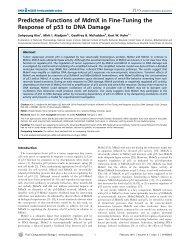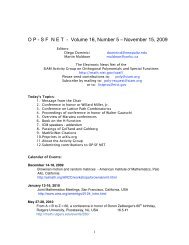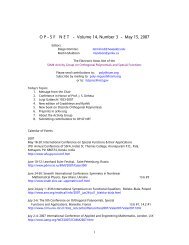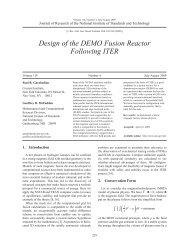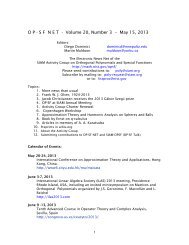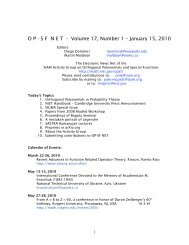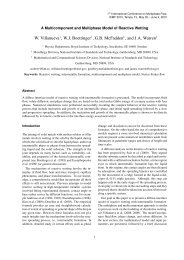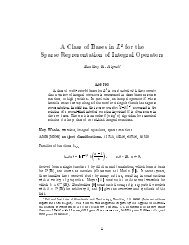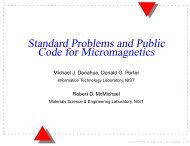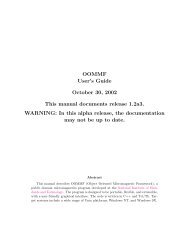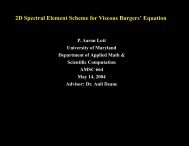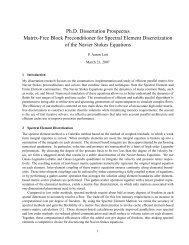The Planetary System - Math, Statistics, and Computational Science
The Planetary System - Math, Statistics, and Computational Science
The Planetary System - Math, Statistics, and Computational Science
Create successful ePaper yourself
Turn your PDF publications into a flip-book with our unique Google optimized e-Paper software.
<strong>The</strong> <strong>Planetary</strong> <strong>System</strong>: Active Documents <strong>and</strong> a<br />
Web3.0 for <strong>Math</strong>.<br />
Michael Kohlhase<br />
http://kwarc.info/kohlhase<br />
Center for Advanced <strong>System</strong>s Engineering<br />
Jacobs University Bremen, Germany<br />
May 30. 2012, NIST<br />
Kohlhase: <strong>Planetary</strong>: Web3.0 for <strong>Math</strong> 1 NIST, May 2012
Introduction<br />
Kohlhase: <strong>Planetary</strong>: Web3.0 for <strong>Math</strong> 2 NIST, May 2012
<strong>The</strong> way we do math will change dramatically<br />
Publication<br />
Compute/<br />
Experiment<br />
Visualize<br />
Com−<br />
munication<br />
<strong>The</strong><br />
Creativity<br />
Spiral<br />
Conjecture<br />
Prove<br />
Application<br />
Specify/<br />
Formalize<br />
<strong>Math</strong>ematical<br />
Creativity<br />
Spiral<br />
[Buchberger 1995]<br />
Teaching<br />
• Every step will be supported by mathematical software systems<br />
• Towards an infrastructure for web-based mathematics!<br />
Kohlhase: <strong>Planetary</strong>: Web3.0 for <strong>Math</strong> 3 NIST, May 2012
e<strong>Math</strong> 3.0: <strong>The</strong> Time is Ripe<br />
• Background:<br />
• Web 2.0 is the term used for the “social Web” (tagging, blogs, wikis, facebook, . . . )<br />
• <strong>The</strong> “Semantic Web” is a version of the Web, where humans & machines cooperate<br />
• Web 3.0 is the term used for the “social Semantic Web”.<br />
• We will apply these to e<strong>Math</strong> ( regular <strong>Math</strong> may or may not change)<br />
Kohlhase: <strong>Planetary</strong>: Web3.0 for <strong>Math</strong> 4 NIST, May 2012
e<strong>Math</strong> 3.0: <strong>The</strong> Time is Ripe<br />
• Background:<br />
• Web 2.0 is the term used for the “social Web” (tagging, blogs, wikis, facebook, . . . )<br />
• <strong>The</strong> “Semantic Web” is a version of the Web, where humans & machines cooperate<br />
• Web 3.0 is the term used for the “social Semantic Web”.<br />
• We will apply these to e<strong>Math</strong> ( regular <strong>Math</strong> may or may not change)<br />
• Recent Improvements of the <strong>Math</strong>-on-the Web Environment:<br />
• <strong>Math</strong>ML3 is out<br />
• <strong>Math</strong>ML enabled in WebKit (in Safari 5.1, on the road for Chrome, Konquerer)<br />
• <strong>Math</strong>ML is in HTML5 (without Namespaces though)<br />
• <strong>Math</strong>Jax has reached 1.0 (Display <strong>Math</strong>ML by JavaScript in many Browsers)<br />
Kohlhase: <strong>Planetary</strong>: Web3.0 for <strong>Math</strong> 4 NIST, May 2012
e<strong>Math</strong> 3.0: <strong>The</strong> Time is Ripe<br />
• Background:<br />
• Web 2.0 is the term used for the “social Web” (tagging, blogs, wikis, facebook, . . . )<br />
• <strong>The</strong> “Semantic Web” is a version of the Web, where humans & machines cooperate<br />
• Web 3.0 is the term used for the “social Semantic Web”.<br />
• We will apply these to e<strong>Math</strong> ( regular <strong>Math</strong> may or may not change)<br />
• Recent Improvements of the <strong>Math</strong>-on-the Web Environment:<br />
• <strong>Math</strong>ML3 is out<br />
• <strong>Math</strong>ML enabled in WebKit (in Safari 5.1, on the road for Chrome, Konquerer)<br />
• <strong>Math</strong>ML is in HTML5 (without Namespaces though)<br />
• <strong>Math</strong>Jax has reached 1.0 (Display <strong>Math</strong>ML by JavaScript in many Browsers)<br />
• Recent Improvements of the Semantic Web:<br />
• RDF can be embedded into XML via RDFa (linked data export)<br />
• RDF querying via SPARQL (modulo OWL Ontologies) (semantic search)<br />
• OMDoc as a mathematical Ontology format (modularity, documentation, full <strong>Math</strong>)<br />
Kohlhase: <strong>Planetary</strong>: Web3.0 for <strong>Math</strong> 4 NIST, May 2012
e<strong>Math</strong> 3.0: <strong>The</strong> Time is Ripe<br />
• Background:<br />
• Web 2.0 is the term used for the “social Web” (tagging, blogs, wikis, facebook, . . . )<br />
• <strong>The</strong> “Semantic Web” is a version of the Web, where humans & machines cooperate<br />
• Web 3.0 is the term used for the “social Semantic Web”.<br />
• We will apply these to e<strong>Math</strong> ( regular <strong>Math</strong> may or may not change)<br />
• Recent Improvements of the <strong>Math</strong>-on-the Web Environment:<br />
• <strong>Math</strong>ML3 is out<br />
• <strong>Math</strong>ML enabled in WebKit (in Safari 5.1, on the road for Chrome, Konquerer)<br />
• <strong>Math</strong>ML is in HTML5 (without Namespaces though)<br />
• <strong>Math</strong>Jax has reached 1.0 (Display <strong>Math</strong>ML by JavaScript in many Browsers)<br />
• Recent Improvements of the Semantic Web:<br />
• RDF can be embedded into XML via RDFa (linked data export)<br />
• RDF querying via SPARQL (modulo OWL Ontologies) (semantic search)<br />
• OMDoc as a mathematical Ontology format (modularity, documentation, full <strong>Math</strong>)<br />
• Overview over the talk:<br />
• <strong>Math</strong>ML3 brings more semantics (strict content <strong>Math</strong>, elementary <strong>Math</strong>)<br />
• integrating <strong>Math</strong>ML/L ATEX into the Web 2.0<br />
• A L ATEX-based Semantic Web for <strong>Math</strong>ematics<br />
Kohlhase: <strong>Planetary</strong>: Web3.0 for <strong>Math</strong> 4 NIST, May 2012
Contributions from KWARC@Jacobs@Bremen<br />
• STEM Knowledge: more like a Digital Library than the Open WWW<br />
(reviewed publication less junk, little duplication, partly inaccessible)<br />
• Combination of Sem<strong>Math</strong> <strong>and</strong> SemWeb<br />
• Expertise in Semantics of STEM Docs<br />
• Expressive Analysis Target Format (OMDoc)<br />
• Software Stack for Semantic Processing<br />
• eSTEM3.0 <strong>System</strong> <strong>Planetary</strong> (Active Docs)<br />
• Invasive authoring (Office/L ATEX)<br />
• Semantic Analysis for L ATEX-based Corpora<br />
(arXiv, ZBL, Planet<strong>Math</strong>. . . )<br />
coverage<br />
• We use <strong>Math</strong> as a test tube for STEM (<strong>Science</strong>, Tech, Eng, & <strong>Math</strong>)<br />
depth<br />
Sem<strong>Math</strong><br />
(ForMeth)<br />
<strong>Math</strong>/Web<br />
Kohlhase: <strong>Planetary</strong>: Web3.0 for <strong>Math</strong> 5 NIST, May 2012<br />
e<strong>Math</strong>3.0<br />
progress<br />
Computer<br />
Support<br />
for STEM<br />
e<strong>Math</strong>3.0<br />
SemWeb<br />
(Life Sci)
Foundations<br />
Kohlhase: <strong>Planetary</strong>: Web3.0 for <strong>Math</strong> 6 NIST, May 2012
<strong>The</strong> Semantic Web<br />
Kohlhase: <strong>Planetary</strong>: Web3.0 for <strong>Math</strong> 7 NIST, May 2012
<strong>The</strong> Current Web<br />
• Resources: identified by URI’s,<br />
untyped<br />
• Links: href, src, . . . limited,<br />
non-descriptive<br />
• User: Exciting world - semantics of<br />
the resource, however, gleaned from<br />
content<br />
• Machine: Very little information<br />
available - significance of the links<br />
only evident from the context around<br />
the anchor.<br />
Kohlhase: <strong>Planetary</strong>: Web3.0 for <strong>Math</strong> 8 NIST, May 2012
<strong>The</strong> Semantic Web<br />
• Resources: Globally Identified by<br />
URI’s or Locally scoped (Blank),<br />
Extensible, Relational<br />
• Links: Identified by URI’s, Extensible,<br />
Relational<br />
• User: Even more exciting world, richer<br />
user experience<br />
• Machine: More processable<br />
information is available (Data Web)<br />
• Computers <strong>and</strong> people: Work, learn<br />
<strong>and</strong> exchange knowledge effectively<br />
Kohlhase: <strong>Planetary</strong>: Web3.0 for <strong>Math</strong> 9 NIST, May 2012
What is the Information a User sees?<br />
WWW2002<br />
<strong>The</strong> eleventh international world wide web conference<br />
Sheraton waikiki hotel<br />
Honolulu, hawaii, USA<br />
7-11 may 2002<br />
1 location 5 days learn interact<br />
Registered participants coming from<br />
australia, canada, chile denmark, france, germany, ghana, hong kong, india,<br />
irel<strong>and</strong>, italy, japan, malta, new zeal<strong>and</strong>, the netherl<strong>and</strong>s, norway,<br />
singapore, switzerl<strong>and</strong>, the united kingdom, the united states, vietnam, zaire<br />
On the 7th May Honolulu will provide the backdrop of the eleventh<br />
international world wide web conference. This prestigious event ?<br />
Speakers confirmed<br />
Tim Berners-Lee: Tim is the well known inventor of the Web, ?<br />
Ian Foster: Ian is the pioneer of the Grid, the next generation internet ?<br />
Kohlhase: <strong>Planetary</strong>: Web3.0 for <strong>Math</strong> 10 NIST, May 2012
What the machine sees<br />
WWW∈′′∈<br />
T〈⌉⌉↕⌉⊑⌉\⊔〈〉\⊔⌉∇\⊣⊔〉≀\⊣↕⊒≀∇↕⌈⊒〉⌈⌉⊒⌉⌊⌋≀\{⌉∇⌉\⌋⌉<br />
S〈⌉∇⊣⊔≀\⊒⊣〉〉〉〈≀⊔⌉↕<br />
H≀\≀↕⊓↕⊓⇔〈⊣⊒⊣〉〉⇔USA<br />
↦↖∞∞⇕⊣†∈′′∈<br />
R⌉}〉∫⊔⌉∇⌉⌈√⊣∇⊔〉⌋〉√⊣\⊔∫⌋≀⇕〉\}{∇≀⇕<br />
⊣⊓∫⊔∇⊣↕〉⊣⇔⌋⊣\⊣⌈⊣⇔⌋〈〉↕⌉⌈⌉\⇕⊣∇⇔{∇⊣\⌋⌉⇔}⌉∇⇕⊣\†⇔}〈⊣\⊣⇔〈≀\}≀\}⇔〉\⌈〉⊣⇔<br />
〉∇⌉↕⊣\⌈⇔〉⊔⊣↕†⇔|⊣√⊣\⇔⇕⊣↕⊔⊣⇔\⌉⊒‡⌉⊣↕⊣\⌈⇔⊔〈⌉\⌉⊔〈⌉∇↕⊣\⌈∫⇔\≀∇⊒⊣†⇔<br />
∫〉\}⊣√≀∇⌉⇔∫⊒〉⊔‡⌉∇↕⊣\⌈⇔⊔〈⌉⊓\〉⊔⌉⌈〉\}⌈≀⇕⇔⊔〈⌉⊓\〉⊔⌉⌈∫⊔⊣⊔⌉∫⇔⊑〉⌉⊔\⊣⇕⇔‡⊣〉∇⌉<br />
O\⊔〈⌉↦⊔〈M⊣†H≀\≀↕⊓↕⊓⊒〉↕↕√∇≀⊑〉⌈⌉⊔〈⌉⌊⊣⌋⌈∇≀√≀{⊔〈⌉⌉↕⌉⊑⌉\⊔〈<br />
〉\⊔⌉∇\⊣⊔〉≀\⊣↕⊒≀∇↕⌈⊒〉⌈⌉⊒⌉⌊⌋≀\{⌉∇⌉\⌋⌉↙T〈〉∫√∇⌉∫⊔〉}〉≀⊓∫⌉⊑⌉\⊔⊥<br />
S√⌉⊣⌉∇∫⌋≀\{〉∇⇕⌉⌈<br />
T〉⇕⌊⌉∇\⌉∇∫↖↕⌉⌉¬T〉⇕〉∫⊔〈⌉⊒⌉↕↕\≀⊒\〉\⊑⌉\⊔≀∇≀{⊔〈⌉W⌉⌊⇔⊥<br />
I⊣\F≀∫⊔⌉∇¬I⊣\〉∫⊔〈⌉√〉≀\⌉⌉∇≀{⊔〈⌉G∇〉⌈⇔⊔〈⌉\⌉§⊔}⌉\⌉∇⊣⊔〉≀\〉\⊔⌉∇\⌉⊔⊥<br />
Kohlhase: <strong>Planetary</strong>: Web3.0 for <strong>Math</strong> 11 NIST, May 2012
Solution: XML markup with “meaningful” Tags<br />
WWW∈′′∈T〈⌉⌉↕⌉⊑⌉\⊔〈〉\⊔⌉∇\⊣⊔〉≀\⊣↕⊒≀∇↕⌈⊒〉⌈⌉⊒⌉⌊⌋≀\{⌉∇⌉\⌋⌉<br />
S〈⌉∇⊣⊔≀\W⊣〉〉〉〈≀⊔⌉↕H≀\≀↕⊓↕⊓⇔〈⊣⊒⊣〉〉⇔USA<br />
↦↖∞∞⇕⊣†∈′′∈<br />
R⌉}〉∫⊔⌉∇⌉⌈√⊣∇⊔〉⌋〉√⊣\⊔∫⌋≀⇕〉\}{∇≀⇕<br />
⊣⊓∫⊔∇⊣↕〉⊣⇔⌋⊣\⊣⌈⊣⇔⌋〈〉↕⌉⌈⌉\⇕⊣∇⇔{∇⊣\⌋⌉⇔}⌉∇⇕⊣\†⇔}〈⊣\⊣⇔〈≀\}≀\}⇔〉\⌈〉⊣⇔<br />
〉∇⌉↕⊣\⌈⇔〉⊔⊣↕†⇔|⊣√⊣\⇔⇕⊣↕⊔⊣⇔\⌉⊒‡⌉⊣↕⊣\⌈⇔⊔〈⌉\⌉⊔〈⌉∇↕⊣\⌈∫⇔\≀∇⊒⊣†⇔<br />
∫〉\}⊣√≀∇⌉⇔∫⊒〉⊔‡⌉∇↕⊣\⌈⇔⊔〈⌉⊓\〉⊔⌉⌈〉\}⌈≀⇕⇔⊔〈⌉⊓\〉⊔⌉⌈∫⊔⊣⊔⌉∫⇔⊑〉⌉⊔\⊣⇕⇔<br />
‡⊣〉∇⌉<br />
O\⊔〈⌉↦⊔〈M⊣†H≀\≀↕⊓↕⊓⊒〉↕↕√∇≀⊑〉⌈⌉⊔〈⌉⌊⊣⌋⌈∇≀√≀{⊔〈⌉⌉↕⌉⊑⌉\⊔〈<br />
〉\⊔⌉∇\⊣⊔〉≀\⊣↕⊒≀∇↕⌈⊒〉⌈⌉⊒⌉⌊⌋≀\{⌉∇⌉\⌋⌉↙<br />
S√⌉⊣⌉∇∫⌋≀\{〉∇⇕⌉⌈<br />
T〉⇕⌊⌉∇\⌉∇∫↖↕⌉⌉¬T〉⇕〉∫⊔〈⌉⊒⌉↕↕\≀⊒\〉\⊑⌉\⊔≀∇≀{⊔〈⌉W⌉⌊<br />
I⊣\F≀∫⊔⌉∇¬I⊣\〉∫⊔〈⌉√〉≀\⌉⌉∇≀{⊔〈⌉G∇〉⌈⇔⊔〈⌉\⌉§⊔}⌉\⌉∇⊣⊔〉≀\<br />
〉\⊔⌉∇\⌉⊔<br />
Kohlhase: <strong>Planetary</strong>: Web3.0 for <strong>Math</strong> 12 NIST, May 2012
What the machine sees of the XML<br />
WWW∈′′∈T〈⌉⌉↕⌉⊑⌉\⊔〈〉\⊔⌉∇\⊣⊔〉≀\⊣↕⊒≀∇↕⌈⊒〉⌈⌉⊒⌉⌊⌋≀\{⌉∇⌉\⌋⌉<br />
S〈⌉∇⊣⊔≀\W⊣〉〉〉〈≀⊔⌉↕H≀\≀↕⊓↕⊓⇔〈⊣⊒⊣〉〉⇔USA<br />
↦↖∞∞⇕⊣†∈′′∈<br />
R⌉}〉∫⊔⌉∇⌉⌈√⊣∇⊔〉⌋〉√⊣\⊔∫⌋≀⇕〉\}{∇≀⇕<br />
⊣⊓∫⊔∇⊣↕〉⊣⇔⌋⊣\⊣⌈⊣⇔⌋〈〉↕⌉⌈⌉\⇕⊣∇⇔{∇⊣\⌋⌉⇔}⌉∇⇕⊣\†⇔}〈⊣\⊣⇔〈≀\}≀\}⇔〉\⌈〉⊣⇔<br />
〉∇⌉↕⊣\⌈⇔〉⊔⊣↕†⇔|⊣√⊣\⇔⇕⊣↕⊔⊣⇔\⌉⊒‡⌉⊣↕⊣\⌈⇔⊔〈⌉\⌉⊔〈⌉∇↕⊣\⌈∫⇔\≀∇⊒⊣†⇔<br />
∫〉\}⊣√≀∇⌉⇔∫⊒〉⊔‡⌉∇↕⊣\⌈⇔⊔〈⌉⊓\〉⊔⌉⌈〉\}⌈≀⇕⇔⊔〈⌉⊓\〉⊔⌉⌈∫⊔⊣⊔⌉∫⇔⊑〉⌉⊔\⊣⇕⇔<br />
‡⊣〉∇⌉<br />
O\⊔〈⌉↦⊔〈M⊣†H≀\≀↕⊓↕⊓⊒〉↕↕√∇≀⊑〉⌈⌉⊔〈⌉⌊⊣⌋⌈∇≀√≀{⊔〈⌉⌉↕⌉⊑⌉\⊔〈<br />
〉\⊔⌉∇\⊣⊔〉≀\⊣↕⊒≀∇↕⌈⊒〉⌈⌉⊒⌉⌊⌋≀\{⌉∇⌉\⌋⌉↙<br />
S√⌉⊣⌉∇∫⌋≀\{〉∇⇕⌉⌈<br />
T〉⇕⌊⌉∇\⌉∇∫↖↕⌉⌉¬T〉⇕〉∫⊔〈⌉⊒⌉↕↕\≀⊒\〉\⊑⌉\⊔≀∇≀{⊔〈⌉W⌉⌊<br />
I⊣\F≀∫⊔⌉∇¬I⊣\〉∫⊔〈⌉√〉≀\⌉⌉∇≀{⊔〈⌉G∇〉⌈⇔⊔〈⌉\⌉§⊔}⌉\⌉∇⊣⊔〉≀\<br />
〉\⊔⌉∇\⌉⊔<br />
Kohlhase: <strong>Planetary</strong>: Web3.0 for <strong>Math</strong> 13 NIST, May 2012
Need to add “Semantics”<br />
• External agreement on meaning of annotations E.g., Dublin Core<br />
• Agree on the meaning of a set of annotation tags<br />
• Problems with this approach: Inflexible, Limited number of things can be expressed<br />
Kohlhase: <strong>Planetary</strong>: Web3.0 for <strong>Math</strong> 14 NIST, May 2012
Need to add “Semantics”<br />
• External agreement on meaning of annotations E.g., Dublin Core<br />
• Agree on the meaning of a set of annotation tags<br />
• Problems with this approach: Inflexible, Limited number of things can be expressed<br />
• Use Ontologies to specify meaning of annotations<br />
• Ontologies provide a vocabulary of terms<br />
• New terms can be formed by combining existing ones<br />
• Meaning (semantics) of such terms is formally specified<br />
• Can also specify relationships between terms in multiple ontologies<br />
Kohlhase: <strong>Planetary</strong>: Web3.0 for <strong>Math</strong> 14 NIST, May 2012
Need to add “Semantics”<br />
• External agreement on meaning of annotations E.g., Dublin Core<br />
• Agree on the meaning of a set of annotation tags<br />
• Problems with this approach: Inflexible, Limited number of things can be expressed<br />
• Use Ontologies to specify meaning of annotations<br />
• Ontologies provide a vocabulary of terms<br />
• New terms can be formed by combining existing ones<br />
• Meaning (semantics) of such terms is formally specified<br />
• Can also specify relationships between terms in multiple ontologies<br />
• Inference with annotations <strong>and</strong> ontologies (get out more than you put in!)<br />
• St<strong>and</strong>ardize annotations in RDF [KC04] or RDFa [BAHS] <strong>and</strong> ontologies on<br />
OWL [w3c09]<br />
• Harvest RDF <strong>and</strong> RDFa in to a triplestore or OWL<br />
•<br />
Kohlhase: <strong>Planetary</strong>: Web3.0 for <strong>Math</strong> 14 NIST, May 2012
<strong>Math</strong>ML: Presentation <strong>and</strong> Content of <strong>Math</strong>ematical<br />
Formulae<br />
Kohlhase: <strong>Planetary</strong>: Web3.0 for <strong>Math</strong> 15 NIST, May 2012
Representation of Formulae as Expression Trees<br />
• <strong>Math</strong>ematical Expressions are build up as expression trees<br />
• of layout schemata in Presentation-<strong>Math</strong>ML<br />
• of functional subexpressions in Content-<strong>Math</strong>ML<br />
• Example: 3<br />
x+2<br />
<br />
3<br />
<br />
x<br />
+<br />
2<br />
<br />
<br />
<br />
<br />
3<br />
<br />
<br />
x<br />
2<br />
<br />
<br />
Kohlhase: <strong>Planetary</strong>: Web3.0 for <strong>Math</strong> 16 NIST, May 2012
Layout Schemata <strong>and</strong> the <strong>Math</strong>ML Box model<br />
3<br />
(x+2)<br />
3 ( x+2 )<br />
x + 2<br />
...<br />
3<br />
...<br />
x + 2<br />
Kohlhase: <strong>Planetary</strong>: Web3.0 for <strong>Math</strong> 17 NIST, May 2012
Content <strong>Math</strong>ml: Expression Trees in Prefix Notation<br />
• Prefix Notation saves parentheses (so does postfix, BTW)<br />
(x − y)/2 x − (y/2)<br />
<br />
<br />
<br />
<br />
x<br />
y<br />
<br />
2<br />
<br />
<br />
<br />
x<br />
<br />
<br />
y<br />
2<br />
<br />
<br />
• Function Application: function arg1 ... argn <br />
• Operators <strong>and</strong> Functions: ∼ 100 empty elements , , ,<br />
,. . .<br />
• Token elements: ci, cn (identifiers <strong>and</strong> numbers)<br />
• Extra Operators: ...<br />
Kohlhase: <strong>Planetary</strong>: Web3.0 for <strong>Math</strong> 18 NIST, May 2012
Parallel Markup e.g. in <strong>Math</strong>ML<br />
• Combine the presentation <strong>and</strong> content markup in one tree <strong>and</strong> crosss-reference<br />
...<br />
3<br />
...<br />
...<br />
x<br />
+<br />
...<br />
2<br />
...<br />
3<br />
...<br />
<br />
x<br />
2<br />
• use e.g. for semantic copy <strong>and</strong> paste.<br />
(click on presentation, follow link <strong>and</strong> copy content)<br />
Kohlhase: <strong>Planetary</strong>: Web3.0 for <strong>Math</strong> 19 NIST, May 2012
Mixing Presentation <strong>and</strong> Content <strong>Math</strong>ML<br />
<br />
<br />
(a + b)<br />
⁢<br />
(c + d)<br />
<br />
<br />
<br />
a b<br />
c d<br />
<br />
<br />
<br />
<br />
<br />
<br />
<br />
<br />
<br />
Kohlhase: <strong>Planetary</strong>: Web3.0 for <strong>Math</strong> 20 NIST, May 2012
Converting the arXiv<br />
Kohlhase: <strong>Planetary</strong>: Web3.0 for <strong>Math</strong> 21 NIST, May 2012
<strong>The</strong> arXMLiv Project: arXiv to semantic XML<br />
• Idea: Develop a large corpus of knowledge in OMDoc/PhysML<br />
• to get around the chicken-<strong>and</strong>-egg problem of MKM<br />
• corpus-linguistic methods for semantics recovery (linguists interested)<br />
• Definition 1 (<strong>The</strong> Cornell Preprint arXiv) (http://www.arxiv.org)<br />
Open access to ca. 700K e-prints in Physics, <strong>Math</strong>ematics, Computer <strong>Science</strong><br />
<strong>and</strong> Quantitative Biology.<br />
• Definition 2 (<strong>The</strong> arXMLiv Project) (http://arxmliv.kwarc.info)<br />
• use Bruce Miller’s L ATEXML to transform to XHTML+<strong>Math</strong>ML<br />
• extend to L ATEXML daemon (RESTful web service) (http://latexml.mathweb.org)<br />
• we have an automated, distributed build system (ca. 2 CPU-years)<br />
• create ca. 12K L ATEXML binding files (8 Jacobs students help)<br />
• use <strong>Math</strong>WebSearch to index XML version (realistic search corpus)<br />
• More semantic information will enable more added-value services, e.g.<br />
• filter hits by model assumptions (exp<strong>and</strong>ing, stationary, or contracting universe)<br />
• use linguistic techniques to add the necessary semantics<br />
Kohlhase: <strong>Planetary</strong>: Web3.0 for <strong>Math</strong> 22 NIST, May 2012
Why reimplement the TEX parser? I<br />
• Problem: <strong>The</strong> TEX parser can change the tokenizer while at runtime (\catcode)<br />
• Example 3 (Obfuscated TEX) David Carlisle posted the following, when<br />
someone claimed that word counting is simple in TEX/L ATEX<br />
\ let ~\ catcode ~ ‘76~ ‘A13~ ‘F1~ ‘j00~ ‘P2 jdefA 71F~ ‘7113 jdefPALLF<br />
PA ’’ FwPA ;; FPAZZFLaLPA //71 F71 iPAHHFLPAzzFenPASSFthP ;A$$ FevP<br />
A@@FfPARR 717273 F 737271 P; ADDFRgniPAWW 71 FPATTFvePA ** FstRsamP<br />
AGGFRruoPAqq 71.72. F 717271 PAYY 7172 F 727171 PA ?? Fi* LmPA &&71 jfi<br />
Fjfi 71 PAVVFjbigskipRPWGAUU 71727374 75 ,76 Fjpar 71727375 Djifx<br />
:76 jelse &U76 jfiPLAKK 7172 F71l 7271 PAXX 71 FVLnOSeL 71 SLRyadR@oL<br />
RrhC ? yLRurtKFeLPFovPgaTLtReRomL ; PABB 71 72 ,73: Fjif .73. jelse<br />
B 73: jfiXF 71 PU 71 72 ,73: PWs ; AMM 71F71 diPAJJFRdriPAQQFRsreLPAI<br />
I71 Fo 71 dPA !! FRgiePBt ’ el@ lTLqdrYmu .Q.,Ke;vz vzLqpip .Q.,tz;<br />
; Lql . IrsZ .eap ,qn.i. i. eLlMaesLdRcna ,;!; h htLqm . MRasZ .ilk ,%<br />
s$;z zLqs ’. ansZ .Ymi ,/ sx ; LYegseZRyal ,@i;@ TLRlogdLrDsW ,@;G<br />
LcYlaDLbJsW , SWXJW ree @rzchLhzsW ,; WERcesInW qt.’oL. Rtrul ;e<br />
doTsW ,Wk; Rri@stW aHAHHFndZPpqar . tridgeLinZpe . LtYer .W ,: jbye<br />
When formatted by TeX, this leads to the full lyrics of “<strong>The</strong> twelve days of<br />
christmas”. When formattet by L ATEXML, it gives<br />
Kohlhase: <strong>Planetary</strong>: Web3.0 for <strong>Math</strong> 23 NIST, May 2012
Why reimplement the TEX parser? II<br />
<br />
<br />
On the first day of Christmas my true love gave to me<br />
a partridge in a pear tree.<br />
<br />
<br />
On the second day of Christmas my true love gave to me<br />
two turtle doves<br />
<strong>and</strong> a partridge in a pear tree.<br />
<br />
<br />
On the third day of Christmas my true love gave to me<br />
three french hens<br />
two turtle doves<br />
<strong>and</strong> a partridge in a pear tree.<br />
<br />
<br />
On the fourth day of Christmas my true love gave to me<br />
four calling birds<br />
three french hens<br />
two turtle doves<br />
<strong>and</strong> a partridge in a pear tree.<br />
<br />
...<br />
Kohlhase: <strong>Planetary</strong>: Web3.0 for <strong>Math</strong> 24 NIST, May 2012
Why reimplement the TEX parser? III<br />
• But the real reason is: that we can take advantage of the semantics in the L ATEX.<br />
• L ATEXML does not need to exp<strong>and</strong> macros, we can tell it about XML equivalents.<br />
• Example 4 (Recovering the Semantics of Proofs)<br />
Add the following magic incantation to amsthm.sty.ltxml (L ATEXML binding)<br />
DefEnvironment(’{proof}’,"#body");<br />
<strong>The</strong> arXMLiv approach: Try to cover most packages <strong>and</strong> classes in the arXiv<br />
(Jacobs undergrads’ intro to research)<br />
Kohlhase: <strong>Planetary</strong>: Web3.0 for <strong>Math</strong> 25 NIST, May 2012
Future Plans for arXMLiv<br />
• State: L ATEX-to-XHTML+<strong>Math</strong>ML Format Conversion works (65% success)<br />
• Over the summer: Bump up success rate to 75%, daily downloads, web site,<br />
instrumentation,. . .<br />
• Soon: Integrate user-level quality control (integrate JS feedback into html)<br />
• starting Fall: Extend post-processing by linguistic methods for semantic analysis<br />
• build semantics blackboard/database for linguistic information (rdf triples)<br />
• extend build system for arbitrary XML2BB processes<br />
• invite the linguists over (they leave semantics results in BB)<br />
• harvest the semantics BB to get OMDoc representations<br />
Kohlhase: <strong>Planetary</strong>: Web3.0 for <strong>Math</strong> 26 NIST, May 2012
Current <strong>and</strong> Possible Applications<br />
• the arxmliv build system http://arxmliv.kwarc.info<br />
• the transformation web service http://tex2xml.kwarc.info<br />
• L ATEXML daemon to avoid perl <strong>and</strong> L ATEX startup times (Deyan Ginev)<br />
• keep LATEXML alive as a daemon that can process multiple files/fragments<br />
(patch memory leaks)<br />
• a L ATEXML client just passes files/fragments along ( 10<br />
s<br />
• embedding/editing L ATEX in web pages http://tex2xml.kwarc.info/test<br />
to 100<br />
s )<br />
• a <strong>Math</strong>ML version of the arXiv allows vision-impared readers to underst<strong>and</strong> the<br />
texts<br />
• generalization search<br />
(need to know sentence structure for detecting universal variables)<br />
• semantic search by academic discipline or theory assumption<br />
(need discourse structure)<br />
• development of scientific vocabularies<br />
(over the past 18 years; drink from the source)<br />
Kohlhase: <strong>Planetary</strong>: Web3.0 for <strong>Math</strong> 27 NIST, May 2012
<strong>Planetary</strong>: An Integrated Platform for e<strong>Math</strong>3.0<br />
Kohlhase: <strong>Planetary</strong>: Web3.0 for <strong>Math</strong> 28 NIST, May 2012
<strong>Planetary</strong>: A Social Semantic e<strong>Science</strong> <strong>System</strong><br />
Kohlhase: <strong>Planetary</strong>: Web3.0 for <strong>Math</strong> 29 NIST, May 2012
<strong>The</strong> <strong>Planetary</strong> <strong>System</strong><br />
• <strong>The</strong> <strong>Planetary</strong> system is a Web 3.0 system for semantically annotated<br />
document collections in <strong>Science</strong>, Technology, Engineering <strong>and</strong> <strong>Math</strong>ematics<br />
(STEM).<br />
• Web 3.0 st<strong>and</strong>s for extension of the Social Web with Semantic Web/Linked<br />
Open Data technologies.<br />
• documents published in the <strong>Planetary</strong> system become flexible, adaptive<br />
interfaces to a content commons of domain objects, context, <strong>and</strong> their relations.<br />
• <strong>Planetary</strong> is based on the Active Documents Paradigm (see next)<br />
• Example 5 (Example installments)<br />
• arxivdemo.mathweb.org (presentation/structural Level: arXiv)<br />
• panta.kwarc.info (semantic level: PantaRhei course system)<br />
• logicatlas.omdoc.org (fully formal level: Logic Representations)<br />
• planetbox.kwarc.info (Technology S<strong>and</strong>box)<br />
• <strong>The</strong> <strong>Planetary</strong> system is finalist in the Elsevier Executable Papers Challenge.<br />
Kohlhase: <strong>Planetary</strong>: Web3.0 for <strong>Math</strong> 30 NIST, May 2012
<strong>The</strong> Active Documents Paradigm<br />
• Definition 6 <strong>The</strong> active documents paradigm (ADP) consists of<br />
• semantically annotated documents together with<br />
• background ontologies (which we call the content commons),<br />
• semantic services that use this information<br />
• a document player application tha embeds services to make documents executable.<br />
Document Commons Content Commons<br />
Active<br />
Documents Active<br />
Active<br />
Documents<br />
Documents<br />
Document<br />
Player<br />
Content<br />
Objects<br />
• Example 7 Services can be program (fragment) execution, computation,<br />
visualization, navigation, information aggregation <strong>and</strong> information retrieval<br />
Kohlhase: <strong>Planetary</strong>: Web3.0 for <strong>Math</strong> 31 NIST, May 2012
OMDoc in a Nutshell (three levels of modeling)<br />
Formula level: Open<strong>Math</strong>/C-<strong>Math</strong>ML<br />
• Objects as logical formulae<br />
• semantics by ref. to theory level<br />
Statement level:<br />
• Definition, <strong>The</strong>orem, Proof, Ex.<br />
• semantics explicit forms <strong>and</strong> refs.<br />
<strong>The</strong>ory level: Development Graph<br />
• inheritance via symbol-mapping<br />
• theory-inclusion by proof-obligations<br />
• local (one-step) vs. global links<br />
<br />
<br />
<br />
<br />
<br />
<br />
rec. eq. for plus<br />
X + 0 = X <br />
X + s(Y ) = s(X + Y )<br />
<br />
Nat−List<br />
Actualization<br />
List<br />
cons, nil cons, nil<br />
0, s, Nat,
Situating OMDoc: <strong>Math</strong> Knowledge Management<br />
Kohlhase: <strong>Planetary</strong>: Web3.0 for <strong>Math</strong> 33 NIST, May 2012
STEX: A Semantic Variant of L ATEX<br />
Kohlhase: <strong>Planetary</strong>: Web3.0 for <strong>Math</strong> 34 NIST, May 2012
TEX/L ATEX as MKM Format: <strong>The</strong> Notation/Context<br />
Problem<br />
• idiosyncratic notations that are introduced, extended, discarded on the fly<br />
λXα.X =α λYα.Y ˆ=I α<br />
meaning of α depends on context: object type vs. mnemonic vs. type label.<br />
• even “st<strong>and</strong>ard notations” depend on the context, e.g. binomial coefficients:<br />
n<br />
k , nC k , C n k , <strong>and</strong> C k n!<br />
n all mean the same thing: k!(n−k)! (cultural context)<br />
• Notation scoping follows complex rules (notations must be introduced)<br />
• “We will write ℘(S) for the set of subsets of S” (for the rest of the doc)<br />
• “We use the notation of [BrHa86], with the exception. . . ”. (by reference)<br />
• “Let S be a set <strong>and</strong> f : S → S. . . ” (scope local in definition)<br />
• “where w is the. . . ” (scope local in preceding formula)<br />
• Book on group theory in Bourbaki series uses notation [Bou: Algebra]<br />
Observation: Notation scoping is different from the one offered by TEX/L ATEX<br />
Kohlhase: <strong>Planetary</strong>: Web3.0 for <strong>Math</strong> 35 NIST, May 2012
TEX/L ATEX as MKM Format: <strong>The</strong> Reconstruction Problem<br />
• <strong>Math</strong>ematical communication relies on the inferential capability of the reader.<br />
• semantically relevant arguments are left out (or ambiguous) to save notational<br />
overload (reader must disambiguate or fill in details.)<br />
log 2(x) vs. log(x) [A] M<br />
ϕ<br />
vs. [A]<br />
• condensed notation: f (x + 1)±2π = g(x − 1)∓2i (st<strong>and</strong>s for 2 equations)<br />
• ad hoc extensions: #(A ∪ B) ≤ #A + #B (exceptions for ∞)<br />
• overt ambiguity: sin x/y vs.<br />
sin x<br />
y vs. sin x<br />
y<br />
vs. −1 ≤ sin x/π ≤ 1<br />
• size of the gaps varies with the intended readership <strong>and</strong> the space constraints.<br />
• can be so substantial, that only a few specialists in the field can underst<strong>and</strong><br />
Kohlhase: <strong>Planetary</strong>: Web3.0 for <strong>Math</strong> 36 NIST, May 2012
<strong>The</strong> STEX approach<br />
• <strong>The</strong> reconstruction <strong>and</strong> the notation/context problem have to be solved to turn<br />
or translate TEX/L ATEX into a MKM format<br />
• Problem: This is impossible in the general case (AI-hard)<br />
• Idea: Enable the author to make structure explicit <strong>and</strong> disambiguate meanings<br />
• use the TEX macro mechanism for this (well established)<br />
• the author knows the semantics best (at least she underst<strong>and</strong>s)<br />
• the burden is is alleviated by manageability savings (MKM on TEX/L ATEX)<br />
• Definition 8 (STEX Approach) Semantic pre-loading of TEX/L ATEX documents.<br />
• Introduce semantic macros: e.g. \union{a,b,c} a ∪ b ∪ c<br />
• Mark up discourse structure: (largely invisible)<br />
e.g. \begin{proof}[id=Wiles,for=Fermat]. . . \end{sproof}<br />
• Generate PDF <strong>and</strong> XML from that (via L ATEXML [Miller])<br />
Kohlhase: <strong>Planetary</strong>: Web3.0 for <strong>Math</strong> 37 NIST, May 2012
STEX Modules help with the Notation/Context Problem<br />
• Note: the context of notations coincides with the context of the concepts they<br />
denote<br />
• Idea: Use the theory structure for notational contexts<br />
• <strong>The</strong> scoping rules of TEX/L ATEX follow a hierarchical model:<br />
• a TEX macro is either globally defined or defined exactly inside the group induced by<br />
the TEX/L ATEX curly braces hierarchy.<br />
• Solution: provide explicit grouping for scope with inheritance.<br />
• new STEX environment module,<br />
• new macro definition \symdef, scoped in module<br />
• specify the inheritance of \symdef-macros in module explicitly<br />
• \symdef-macros are undefined unless in home module or inherited.<br />
Kohlhase: <strong>Planetary</strong>: Web3.0 for <strong>Math</strong> 38 NIST, May 2012
STEX Modules: Example<br />
\begin{module}[id=pairs]\symdef{pair}[2]{\langle#1,#2\rangle} ...\end{module}<br />
\begin{module}[id=sets]<br />
\symdef{member}[2]{#1\in #2} % set membership<br />
\symdef{mmember}[2]{#1\in #2} ... % aggregated set membership<br />
\end{module}<br />
\begin{module}[id=setoid]<br />
\importmodule{pairs}<br />
\importmodule{sets}<br />
\symdef{sset}{\mathcal{S}} % the base set<br />
\symdef{sopa}{\circ} % the operation symbol<br />
\symdef{sop}[2]{(#1\sopa #2)} % the operation applied<br />
\begin{definition}[id=setoid.def]<br />
A structure $\pair\sset\sopa$ is called a \defi{setoid}, if $\sset$ is closed under<br />
$\sopa$, i.e. if $\member{\sop{a}{b}}\sset$ for all $\mmember{a,b}\sset$.<br />
\end{definition}<br />
\end{module}<br />
\begin{module}[id=semigroup]<br />
\importmodule{setoid}<br />
\begin{definition}[id=monoid.def]<br />
A \trefi[setoid]{setoid} $\pair\sset\sopa$ is called a \defi{monoid}, if $\sopa$ is<br />
associative on $\sset$, i.e. if $\sop{a}{\sop{b}{c}}=\sop{\sop{a}{b}}{c}$ for all<br />
$\mmember{a,b,c}\sset$.<br />
\end{definition}<br />
\end{module}<br />
Kohlhase: <strong>Planetary</strong>: Web3.0 for <strong>Math</strong> 39 NIST, May 2012
<strong>The</strong> Result of the Example<br />
• Empirically: Explicit module structure<br />
• is a little overhead (can be automated/supported by IDE [JK10])<br />
• more semantic/portable (but I might be brainwashed)<br />
• In our case study: 320 slides, 160 modules, depth ∼ 25<br />
Kohlhase: <strong>Planetary</strong>: Web3.0 for <strong>Math</strong> 40 NIST, May 2012
LaMaPUn:Semantic Analysis for Docs with <strong>Math</strong> (L ATEX)<br />
Kohlhase: <strong>Planetary</strong>: Web3.0 for <strong>Math</strong> 41 NIST, May 2012
Realizing <strong>Planetary</strong><br />
Kohlhase: <strong>Planetary</strong>: Web3.0 for <strong>Math</strong> 42 NIST, May 2012
Realizing <strong>Planetary</strong>: <strong>The</strong> KWARC stack<br />
We have already developed the necessary tools/systems over the last decade<br />
<strong>Planetary</strong> is the ideal test bed to integrate them.<br />
Kohlhase: <strong>Planetary</strong>: Web3.0 for <strong>Math</strong> 43 NIST, May 2012
Assembling <strong>Planetary</strong>: <strong>System</strong> Architecture<br />
• <strong>Planetary</strong> functionality can be achieved by integrating existing components.<br />
L ATEXML<br />
Firefox Drupal HTML5 TNTBase<br />
JOBAD<br />
REST<br />
HTML5<br />
STEX<br />
SPARQL<br />
Virtuoso<br />
• Drupal for discussions, user management, caching,<br />
• TNTBase for versioned XML storage, OMDoc presentation<br />
• JOBAD integrates semantic services into documents<br />
• Virtuoso is a triple store for semantic relations<br />
• L ATEXML transforms L ATEX/STEX to XHTML+<strong>Math</strong>ML+RDFa<br />
Kohlhase: <strong>Planetary</strong>: Web3.0 for <strong>Math</strong> 44 NIST, May 2012<br />
Content<br />
Management<br />
<strong>System</strong><br />
OMDoc<br />
RDF
Organization of Content/Narrative Structure<br />
Kohlhase: <strong>Planetary</strong>: Web3.0 for <strong>Math</strong> 45 NIST, May 2012
Layers of Documents/Content<br />
• Content <strong>and</strong> narrative structures come at different conceptual layers<br />
Level<br />
3<br />
2<br />
1<br />
0<br />
Active Documents<br />
4 Planet<strong>Math</strong> PantaRhei Instance<br />
Encyclopedia<br />
Article<br />
Course<br />
Notes/Problems/Exams<br />
Learning Object<br />
Slide<br />
• Different layers support different functionality<br />
Content Commons<br />
Library<br />
Collection<br />
Monograph<br />
Module<br />
Object<br />
Kohlhase: <strong>Planetary</strong>: Web3.0 for <strong>Math</strong> 46 NIST, May 2012
Monographs as Module Graphs foster Reuse<br />
• Idea: Modules can be reused in more than one monograph<br />
• Note: Similar to, but more general (nesting) than DITA concepts <strong>and</strong> DITA<br />
maps. (but no conditional processing (yet))<br />
• Example 9 For instance a module on HTML/XML in the courses “General<br />
Computer <strong>Science</strong>” <strong>and</strong> “Text <strong>and</strong> Digital Media”.<br />
strings<br />
codes<br />
prefix<br />
codes<br />
GenCS<br />
2011<br />
. . .<br />
UniCode<br />
XHTML<br />
XML<br />
TDM<br />
2011<br />
. . .<br />
Manuals<br />
DocBook DITA<br />
Observation: <strong>The</strong>se graphs can get quite large: Our corpus has 3300 nodes with<br />
130 roots.<br />
Kohlhase: <strong>Planetary</strong>: Web3.0 for <strong>Math</strong> 47 NIST, May 2012
Monographs as Module Graphs foster Reuse<br />
• Idea: Modules can be reused in more than one monograph<br />
• Note: Similar to, but more general (nesting) than DITA concepts <strong>and</strong> DITA<br />
maps. (but no conditional processing (yet))<br />
• Example 10 For instance a module on HTML/XML in the courses “General<br />
Computer <strong>Science</strong>” <strong>and</strong> “Text <strong>and</strong> Digital Media”.<br />
strings<br />
codes<br />
GenCS<br />
2010<br />
prefix<br />
codes<br />
GenCS<br />
2011<br />
. . .<br />
GenCS<br />
2012<br />
UniCode<br />
XHTML<br />
XML<br />
TDM<br />
2011<br />
. . .<br />
TDM<br />
2012<br />
Manuals<br />
DocBook DITA<br />
Courses given in different years share most of their content (but not all)<br />
• Observation: <strong>The</strong>se graphs can get quite large: Our corpus has 3300 nodes with<br />
130 roots.<br />
Kohlhase: <strong>Planetary</strong>: Web3.0 for <strong>Math</strong> 47 NIST, May 2012
JOBAD: Embedding Semantic Services into Web Docs I<br />
• JavaScript API for (J)OMDoc Based Active Documents<br />
• runs inside client browser (FireFox currently)<br />
• provides client-only or server-based features (extensible framework)<br />
based on semantic annotations in XHTML+<strong>Math</strong>ML+RDFa documents<br />
• Project home page: https://jomdoc.omdoc.org/wiki/JOBAD<br />
Kohlhase: <strong>Planetary</strong>: Web3.0 for <strong>Math</strong> 48 NIST, May 2012
OMDoc in a Nutshell (three levels of modeling)<br />
Formula level: Open<strong>Math</strong>/C-<strong>Math</strong>ML<br />
• Objects as logical formulae<br />
• semantics by ref. to theory level<br />
Statement level:<br />
• Definition, <strong>The</strong>orem, Proof, Ex.<br />
• semantics explicit forms <strong>and</strong> refs.<br />
<strong>The</strong>ory level: Development Graph<br />
• inheritance via symbol-mapping<br />
• theory-inclusion by proof-obligations<br />
• local (one-step) vs. global links<br />
<br />
<br />
<br />
<br />
<br />
<br />
rec. eq. for plus<br />
X + 0 = X <br />
X + s(Y ) = s(X + Y )<br />
<br />
Nat−List<br />
Actualization<br />
List<br />
cons, nil cons, nil<br />
0, s, Nat,
L ATEXML: Converting TEX/L ATEX Documents to XML<br />
• Definition 11 L ATEXML converts L ATEX documents to XHTML+<strong>Math</strong>ML<br />
• re-implement the TEX parser in perl. (do not exp<strong>and</strong> semantic macros)<br />
• needs L ATEXML bindings for all L ATEX packages <strong>and</strong> classes<br />
(specify the XML for the emitter)<br />
Case Study: Converting the arXiv into XHTML+<strong>Math</strong>ML<br />
(70% coverage of 550 k documents)<br />
Kohlhase: <strong>Planetary</strong>: Web3.0 for <strong>Math</strong> 51 NIST, May 2012
STEX, a Semantic Variant of TEX/L ATEX<br />
• Problem: Need content markup formats for semantic services, but<br />
<strong>Math</strong>ematicians write L ATEX<br />
• Idea: Enable the author to make structure explicit <strong>and</strong> disambiguate meanings<br />
• use the TEX macro mechanism for this (well established)<br />
• the author knows the semantics best (at least she underst<strong>and</strong>s)<br />
• the burden is is alleviated by manageability savings (MKM on TEX/L ATEX)<br />
• Definition 12 (STEX Approach) Semantic pre-loading of TEX/L ATEX<br />
documents.<br />
• Introduce semantic macros: e.g. \union{a,b,c} a ∪ b ∪ c<br />
• Mark up discourse structure: (largely invisible)<br />
e.g. \begin{sproof}[id=Wiles,for=Fermat]. . . \end{sproof}<br />
• Generate PDF <strong>and</strong> OMDoc from that (via L ATEXML [Mil])<br />
http://trac.kwarc.info/sTeX/<br />
Kohlhase: <strong>Planetary</strong>: Web3.0 for <strong>Math</strong> 52 NIST, May 2012
Levels of Service in <strong>Planetary</strong><br />
Kohlhase: <strong>Planetary</strong>: Web3.0 for <strong>Math</strong> 53 NIST, May 2012
<strong>Planetary</strong> at the Presentation/Structural Level<br />
• <strong>Planetary</strong> can make use objects <strong>and</strong> relations at various levels,<br />
• Example 13 (arXivdemo: Document Structure <strong>and</strong> Presentational <strong>Math</strong>)<br />
Kohlhase: <strong>Planetary</strong>: Web3.0 for <strong>Math</strong> 54 NIST, May 2012
User Services at the Semantic Level in <strong>Planetary</strong><br />
Definition Lookup<br />
Semantic Folding<br />
⇓<br />
Unit Conversion<br />
Prerequisites Navigation<br />
Kohlhase: <strong>Planetary</strong>: Web3.0 for <strong>Math</strong> 55 NIST, May 2012
PantaRhei: Semantic Course Knowledge Exploration<br />
• PantaRhei is a semantic course knowledge exploration system based on the<br />
<strong>Planetary</strong> system.<br />
Kohlhase: <strong>Planetary</strong>: Web3.0 for <strong>Math</strong> 56 NIST, May 2012
User Services at the Formal Level in <strong>Planetary</strong><br />
• Formal Representations Adapted to Distinct User Settings<br />
(Customized via the Dashboard Widget on the Right)<br />
Kohlhase: <strong>Planetary</strong>: Web3.0 for <strong>Math</strong> 57 NIST, May 2012
Accessing Encyclopedias via Ontologies<br />
• Idea: add classification metadata to articles, harvest as RDF into triplestore,<br />
compute access methods via SPARQL queries <strong>and</strong> SKOS ontology.<br />
• Example 14 (MSC View in Planet<strong>Math</strong>) use the <strong>Math</strong> Subject Classification<br />
Kohlhase: <strong>Planetary</strong>: Web3.0 for <strong>Math</strong> 58 NIST, May 2012
Ontology-Based Management of Change; A Killer<br />
Application for Semantic Techniques<br />
Kohlhase: <strong>Planetary</strong>: Web3.0 for <strong>Math</strong> 59 NIST, May 2012
Application: Formal Software Development<br />
• Idea: Underst<strong>and</strong>, markup, & version development documents<br />
• Example 15 For instance in the V Model<br />
Requirements<br />
Specification<br />
<strong>System</strong><br />
Specification<br />
<strong>System</strong> Design<br />
(High⌧level)<br />
<strong>System</strong> Design<br />
(Detail level)<br />
Customer<br />
Approval<br />
Product<br />
Delivery<br />
<strong>System</strong><br />
integration<br />
<strong>System</strong><br />
Implementation<br />
Verification & Validation<br />
Problem: We need to underst<strong>and</strong> hybrid documents (text, math, UML, code)<br />
Kohlhase: <strong>Planetary</strong>: Web3.0 for <strong>Math</strong> 60 NIST, May 2012<br />
Change<br />
Specification & Decomposition<br />
Implementation & Integration
Management of Change in <strong>Planetary</strong><br />
Kohlhase: <strong>Planetary</strong>: Web3.0 for <strong>Math</strong> 61 NIST, May 2012
Management of Change in <strong>Planetary</strong><br />
• Observation: In an e<strong>Science</strong>3.0 <strong>System</strong>, the content is constantly changing.<br />
• Problem: How do we maintain consistency <strong>and</strong> coherence<br />
• Idea: Integrate functionality for Management of Change.<br />
• Make use of the semantic relations already in place in <strong>Planetary</strong>.<br />
• If A depends on B, then a change in B impacts A.<br />
• Extend <strong>Planetary</strong> by the DocTIP system from OMoC.<br />
(Joint project with DFKI Bremen).<br />
• Prototypical Integration in <strong>Planetary</strong> available [ADD + 11]<br />
STEX<br />
<strong>Planetary</strong> TNTBase DocTIP<br />
XHTML<br />
OMDoc<br />
Impacts<br />
Kohlhase: <strong>Planetary</strong>: Web3.0 for <strong>Math</strong> 62 NIST, May 2012
Change Impact Analysis in DocTIP<br />
• Idea: If A depends on B, then a change in B impacts A.<br />
• Definition 16 Change Imact Analysis (CIA) is a process for computing<br />
potentially impacted fragments in a document collection C from a change<br />
description <strong>and</strong> semantic relations in C.<br />
• In DocTIP, CIA is computed by graph rewriting rules on the document ontology.<br />
• Example 17 CIA propagation rules for OMDoc<br />
origin<br />
origin<br />
origin<br />
Definition<br />
<strong>The</strong>orem<br />
uses<br />
Proof<br />
occurs<br />
(a) Initial Syntax <strong>and</strong> Semantics<br />
origin<br />
origin<br />
origin<br />
Definition<br />
<strong>The</strong>orem<br />
uses<br />
Proof<br />
occurs<br />
Def. changed<br />
Def. changed<br />
(b) Propagated Impacts after Definition<br />
Change<br />
Kohlhase: <strong>Planetary</strong>: Web3.0 for <strong>Math</strong> 63 NIST, May 2012
MoC in <strong>Planetary</strong> I<br />
• Extend the commit dialog with CIA<br />
Kohlhase: <strong>Planetary</strong>: Web3.0 for <strong>Math</strong> 64 NIST, May 2012
MoC in <strong>Planetary</strong> II<br />
• <strong>The</strong> Impact Resolution Dialog<br />
Kohlhase: <strong>Planetary</strong>: Web3.0 for <strong>Math</strong> 65 NIST, May 2012
Searching for <strong>Math</strong>ematical Formulae<br />
Kohlhase: <strong>Planetary</strong>: Web3.0 for <strong>Math</strong> 66 NIST, May 2012
Introduction & Motivation<br />
Kohlhase: <strong>Planetary</strong>: Web3.0 for <strong>Math</strong> 67 NIST, May 2012
Why we need a search engine for <strong>Math</strong>ematics<br />
• We have come to rely on the World Wide Web for almost all of our information<br />
needs.<br />
• <strong>The</strong> Internet is only the transport layer. We see a succession of techniques<br />
Early Web navigation via explicitly represented hyperlinks<br />
Mature Web finding relevant content via search engines<br />
(bag of words techniques for textual content)<br />
Semantic Web Representation of meaning <strong>and</strong> inferring content that is not<br />
explicitly represented<br />
• For scientific content, we are still in the “Early Web” phase<br />
• Need a “Semantic Web for <strong>Science</strong>” (talk about OMDoc some other time)<br />
• Today: provide techniques for the “Mature Web”<br />
• Concretely: a search engine for math. formulae<br />
(a prominent non-textual part of science)<br />
Kohlhase: <strong>Planetary</strong>: Web3.0 for <strong>Math</strong> 68 NIST, May 2012
<strong>Math</strong>ematics Resources on the Web<br />
Kohlhase: <strong>Planetary</strong>: Web3.0 for <strong>Math</strong> 69 NIST, May 2012
More <strong>Math</strong>ematics on the Web<br />
• <strong>The</strong> Connexions project (http://cnx.org)<br />
• Wolfram Inc. (http://functions.wolfram.com)<br />
• Eric Weisstein’s <strong>Math</strong>World (http://mathworld.wolfram.com)<br />
• Digital Library of <strong>Math</strong>ematical Functions (http://dlmf.nist.gov)<br />
• Cornell ePrint arXiv (http://www.arxiv.org)<br />
• Zentralblatt <strong>Math</strong> (http://www.zentralblatt-math.org)<br />
• · · ·<br />
• Question: How will we find content that is relevant to our needs<br />
• Idea: try Google (like we always do)<br />
• Scenario: Try finding the distributivity property for Z<br />
(∀k, l, m ∈ Z.k · (l + m) = (k · l) + (k + m))<br />
Kohlhase: <strong>Planetary</strong>: Web3.0 for <strong>Math</strong> 70 NIST, May 2012
Searching for Distributivity<br />
Kohlhase: <strong>Planetary</strong>: Web3.0 for <strong>Math</strong> 71 NIST, May 2012
Searching for Distributivity<br />
Kohlhase: <strong>Planetary</strong>: Web3.0 for <strong>Math</strong> 72 NIST, May 2012
Searching for Distributivity<br />
Kohlhase: <strong>Planetary</strong>: Web3.0 for <strong>Math</strong> 73 NIST, May 2012
Of course Google cannot work out of the box<br />
• Formulae are not words:<br />
• a, b, c, k, l, m, x, y, <strong>and</strong> z are (bound) variables.<br />
(do not behave like words/symbols)<br />
• where are the word boundaries for “bag-of-words” methods?<br />
• Idea: Need a special treatment for formulae (translate into “special words”)<br />
Indeed this is done ([MY03, MM06, LM06, MG11]) . . . <strong>and</strong> works surprisingly<br />
well (using Lucene as an indexing engine)<br />
• Idea: Use database techniques (extract metadata <strong>and</strong> index it)<br />
Indeed this is done for the Coq/HELM corpus ([Asperti&al’04])<br />
• Our Idea: Use Automated Reasoning Techniques<br />
(free term indexing from theorem prover jails)<br />
Kohlhase: <strong>Planetary</strong>: Web3.0 for <strong>Math</strong> 74 NIST, May 2012
A running example: <strong>The</strong> Power of a Signal<br />
• An engineer wants to compute the power of a given signal s(t)<br />
• She remembers that it involves integrating the square of s.<br />
• Problem: But how to compute the necessary integrals<br />
• Idea: call up <strong>Math</strong>WebSearch with ?<br />
? s2 (t)dt.<br />
• <strong>Math</strong>WebSearch finds a document about Parseval’s <strong>The</strong>orem <strong>and</strong><br />
1<br />
T<br />
T<br />
0 s2 (t)dt = Σ ∞ k=−∞ |ck| 2 where ck are the Fourier coefficients of s(t).<br />
Kohlhase: <strong>Planetary</strong>: Web3.0 for <strong>Math</strong> 75 NIST, May 2012
Some other Problems (Why do we need more?)<br />
• Substitution Instances: search for x 2 + y 2 = z2 , find 33 + 42 = 52 • Homonymy: n<br />
k , nC k , C n k , <strong>and</strong> C k n all mean the same thing (binomial coeff.)<br />
• Solution: use content-based representations (<strong>Math</strong>ML, Open<strong>Math</strong>)<br />
• <strong>Math</strong>ematical Equivalence: e.g. f (x)dx means the same as f (y)dy<br />
(α-equivalence)<br />
• Solution: build equivalence (e.g. α or ACI) into the search engine<br />
(or normalize first [Normann’06])<br />
• Subterms: Retrieve formulae by specifying some sub-formulae<br />
• Solution: record locations of all sub-formulae as well<br />
Kohlhase: <strong>Planetary</strong>: Web3.0 for <strong>Math</strong> 76 NIST, May 2012
Term Indexing<br />
Kohlhase: <strong>Planetary</strong>: Web3.0 for <strong>Math</strong> 77 NIST, May 2012
Term-Indexing<br />
• Motivation: Automated theorem proving (efficient systems)<br />
• Problem: Decreasing inference rate (basic operations linear in # of formulae)<br />
• Idea: Make use of structural equality between terms (term indexing)<br />
database systems (Algorithms: select, meet, join)<br />
• Data: PERSON(hans, manager, 32)<br />
• Query:“find all 40-year old persons”<br />
Data<br />
automated theorem proving (Algorithm: Unification)<br />
• Data: P(f (x, g(a, b)))<br />
• Queries: “find all literals that are unifiable with P(f (c, y))”<br />
Terms<br />
An (additional) index data structure can make the retrieval logarithmic<br />
Kohlhase: <strong>Planetary</strong>: Web3.0 for <strong>Math</strong> 78 NIST, May 2012<br />
Index<br />
Index
Tree-based Indexing: use structural similarity of terms<br />
h<br />
a<br />
Discrimiation Tree Abstraction Tree<br />
f<br />
g<br />
* d<br />
* h h<br />
* *<br />
f (a, h(x)) f (g(y), h(y)) f (g(d), h(z))<br />
f (x3, h(x4))<br />
[x3, x5]<br />
a, x g(x5), x6<br />
[x5, x6]<br />
y, y d, z<br />
f (a, h(x)) f (g(y), h(y)) f (g(d), h(z))<br />
Terms as linear chains, shared in trees Trees of substitution instances<br />
Kohlhase: <strong>Planetary</strong>: Web3.0 for <strong>Math</strong> 79 NIST, May 2012
Substitution Tree [Graf ’94]<br />
u ↦→ f (x1, h(∗1))<br />
x1 ↦→ a x1 ↦→ g(x3)<br />
x3 ↦→ ∗1 x3 ↦→ d<br />
u ↦→ f (a, h(x)) u ↦→ f (g(y), h(y)) u ↦→ f (g(d), h(z))<br />
• Variant of abstraction trees that indexes Substitutions<br />
(Nodes labeled with Substitutions)<br />
• includes Variable renaming (∗i ˆ= i th variable)<br />
• less redundant than abstraction trees<br />
• allows n : m indexing<br />
Kohlhase: <strong>Planetary</strong>: Web3.0 for <strong>Math</strong> 80 NIST, May 2012
Unification-based Search<br />
Kohlhase: <strong>Planetary</strong>: Web3.0 for <strong>Math</strong> 81 NIST, May 2012
Unification-Based Querying for <strong>Math</strong>. Formulae<br />
• <strong>The</strong>ory: Substitution Tree Indexing is a perfect filter for<br />
• Variants: {σ | σ ∈ GEN(τ, ρ) ∧ supp(σ) ∩ V ∗ = ∅}<br />
• Instances: {σ | σ ∈ UNIF(τ, ρ) ∧ supp(σ) ∩ V ∗ = ∅}<br />
• Generalization: {σ | ∀xi ∈ supp(τ) τρσ(xi) = ρ(xi)}<br />
• Unification: {σ | ∀xi ∈ supp(τ) τρσ(xi) = ρσ(xi)σ mgu}<br />
• Idea: Use all of them for querying Formulae mathematical Formulae<br />
• Variants: To find formulae of a given structure<br />
• Instances: To find formulae of a partially remembered structure<br />
• Generalization: To find appliccable <strong>The</strong>orems<br />
• Unification: A mixture of all three.<br />
Kohlhase: <strong>Planetary</strong>: Web3.0 for <strong>Math</strong> 82 NIST, May 2012
<strong>Math</strong>WebSearch: Search <strong>Math</strong>. Formulae on the Web<br />
• Idea 1: Crawl the Web for math. formulae (in Open<strong>Math</strong> or C<strong>Math</strong>ML)<br />
• Idea 2: <strong>Math</strong>. formulae can be represented as first order terms (see below)<br />
• Idea 3: Index them in a substitution tree index (for efficient retrieval)<br />
• Problem: Find a query language that is intuitive to learn<br />
• Idea 4: Reuse the XML syntax of Open<strong>Math</strong> <strong>and</strong> C<strong>Math</strong>ML, add variables<br />
Kohlhase: <strong>Planetary</strong>: Web3.0 for <strong>Math</strong> 83 NIST, May 2012
Indexing <strong>Math</strong> Formulae as First-Order Terms?<br />
• <strong>Math</strong>ematical Expression: ∞<br />
0 s 2 (t)dt.<br />
• Content <strong>Math</strong>ML: Formulae built up by function application, <strong>and</strong> binding from<br />
constants <strong>and</strong> variables.<br />
<br />
<br />
0<br />
<br />
<br />
t<br />
<br />
st<br />
2<br />
<br />
<br />
<br />
<br />
Idea: Extend Substitution Tree Indexing with bound variables <strong>and</strong> α-renaming<br />
• Technically: Use deBruijn Indexes<br />
(bvars as name-less pointers interact well with substitution)<br />
Kohlhase: <strong>Planetary</strong>: Web3.0 for <strong>Math</strong> 84 NIST, May 2012
Instantiation Queries<br />
• Application: Find partially remembered formulae<br />
• Example 18 An engineer might face the problem remembering the energy of a<br />
given signal f (x)<br />
• Problem: hmmmm, have to square it <strong>and</strong> integrate<br />
max<br />
• Query Term: f (x)<br />
min<br />
2 dx ( i are search variables)<br />
• One Hit: Parseval’s <strong>The</strong>orem 1<br />
T<br />
T 0<br />
s 2 (t)dt =<br />
∞<br />
k=−∞<br />
ck 2 (nice, I can compute it)<br />
• This works out of the box (has ween working in <strong>Math</strong>WebSearch for some time)<br />
• Another Application: Underspecified Conjectures/<strong>The</strong>orem Proving<br />
• during theory exploration we often have some freedom<br />
• express that using metavariables in conjectures<br />
• instantiate the conjecture metavariables as the proof as the proof dictates<br />
applied e.g. in Alan Bundy’s “middle-out reasoning” in proof planing<br />
Kohlhase: <strong>Planetary</strong>: Web3.0 for <strong>Math</strong> 85 NIST, May 2012
Generalization Queries<br />
• Application: Find (possibly) appliccable theorems<br />
• Example 19 A researcher wants to estimate <br />
R2 | sin(t) cos(t)|dt from above<br />
• Problem: Find inequation such that <br />
R 2 | sin(t) cos(t)|dt matches left h<strong>and</strong> side.<br />
• e.g. Hölder’s Inequality: ( i are universal variables)<br />
<br />
<br />
<br />
<br />
<br />
f (x) g (x) dx ≤ f (x) <br />
D<br />
D<br />
p<br />
1 <br />
p <br />
<br />
dx g (x) <br />
D<br />
q<br />
dx<br />
• Solution: Take the instance<br />
<br />
R 2<br />
<br />
|sin(x)cos(x)| dx ≤<br />
R 2<br />
1 q<br />
|sin(x)| p 1 <br />
p<br />
dx<br />
R2 |cos(x)| q 1<br />
q<br />
dx<br />
Problem: Where do the index formulae come from in particular the universal<br />
variables (we’ll come back to that later)<br />
Kohlhase: <strong>Planetary</strong>: Web3.0 for <strong>Math</strong> 86 NIST, May 2012
Unification Queries<br />
• Application: Find appliccable theorems for underspecified formulae<br />
• Example 20 estimate g 2 cos( x ) + b sin( √ y)<br />
• this unifies with a cos( t ) + b sin( t ) ≤ ?<br />
• result: g 2 cos( √ y) + b sin( √ y) ≤ σ(?), where σ is the mgu<br />
Problem: Users find it difficult to state the exact unification query<br />
• Solution: (from Databases again)<br />
• express the query in SELECT FROM WHERE form.<br />
<br />
<br />
1<br />
• e.g. SELECT instance √ exp {B} WHERE B=variation(x<br />
D 2π 2 + jy 2 )<br />
• <strong>Math</strong>WebSearch preprocessor compiles subqueries into one unification query for<br />
efficiency.<br />
Kohlhase: <strong>Planetary</strong>: Web3.0 for <strong>Math</strong> 87 NIST, May 2012
Where do the universal variables come from<br />
• Problem: we need to have e.g. Hölder’s Inequality in the index:<br />
<br />
<br />
<br />
<br />
<br />
f (x) g (x) dx ≤ f (x) <br />
D<br />
D<br />
p<br />
1<br />
p<br />
dx<br />
<br />
<br />
g (x) <br />
D<br />
q<br />
dx<br />
• How do we know what symbols are “universal” (to be instantiated?)<br />
• what is their scope (when are different occurrences of f different?)<br />
• we have no sources with explicit quantifiers, but ([Wikipedia])<br />
Let (D, Σ, µ) be a measure space <strong>and</strong> let 1 ≤ p, q ≤ ∞ with 1/p + 1/q = 1.<br />
<strong>The</strong>n, for all measurable real- or complex-valued functions f <strong>and</strong> g on D, . . .<br />
• Solution: Use techniques from computational linguistics <strong>and</strong> integrate them into<br />
the indexing pipeline. (we have started a bit on the arXiv)<br />
Kohlhase: <strong>Planetary</strong>: Web3.0 for <strong>Math</strong> 88 NIST, May 2012<br />
1<br />
q
<strong>The</strong> <strong>Math</strong>WebSearch <strong>System</strong><br />
Kohlhase: <strong>Planetary</strong>: Web3.0 for <strong>Math</strong> 89 NIST, May 2012
<strong>System</strong> Architecture<br />
• crawlers for <strong>Math</strong>ML, Open<strong>Math</strong>, <strong>and</strong> OAI repositories. (convert your’s?)<br />
• multiple search servers based substitution tree indexing (formula search)<br />
• a RESTful server that acts as a front-end for multiple search servers.<br />
• various front ends tailored to specific applications (search appliances)<br />
• a Google-like web front end for human users (search.mathweb.org)<br />
• a L ATEX-based front-end for the arXiv (http://arxivdemo.mathweb.org)<br />
• special integrations for theorem prover libraries (MizarWiki, TPTP)<br />
Kohlhase: <strong>Planetary</strong>: Web3.0 for <strong>Math</strong> 90 NIST, May 2012
Index statistics<br />
• Experiment: Indexing the arXiv (700k documents, ∼ 10 8 non-trivial formulae)<br />
• Results: indexing up to 15 M formulae on a st<strong>and</strong>ard laptop<br />
Query Times Memory Footprint<br />
• query time is constant (∼ 50 ms) (as expected; goes by depth × symbols)<br />
• memory footprint seems linear (∼ 100<br />
• So we need ca 15 GB RAM for indexing the whole arXiv.<br />
B<br />
) (expected more duplicates)<br />
formula<br />
• Can index all published <strong>Math</strong> ( ˆ= 5 × arXiv) on a large server. (ZBL ˆ= 3M art.)<br />
Kohlhase: <strong>Planetary</strong>: Web3.0 for <strong>Math</strong> 91 NIST, May 2012
Instead of a Demo: Searching for Signal Power<br />
Kohlhase: <strong>Planetary</strong>: Web3.0 for <strong>Math</strong> 92 NIST, May 2012
Instead of a Demo: Search Results<br />
Kohlhase: <strong>Planetary</strong>: Web3.0 for <strong>Math</strong> 93 NIST, May 2012
Instead of a Demo: L ATEX-based Search on the arXiv<br />
Kohlhase: <strong>Planetary</strong>: Web3.0 for <strong>Math</strong> 94 NIST, May 2012
Instead of a Demo: Appliccable <strong>The</strong>orem Search in Mizar<br />
Kohlhase: <strong>Planetary</strong>: Web3.0 for <strong>Math</strong> 95 NIST, May 2012
But <strong>Math</strong> consists of more than Formulae<br />
• Idea: Text <strong>and</strong> Formulae co-constrain each other in search<br />
would like to search for formulae as well als words<br />
• Problem: turnkey text search engines exist, but are incompatible with<br />
<strong>Math</strong>WebSearch<br />
• Solution: MaTeSearch combines text <strong>and</strong> formula search results.<br />
1 compute text/formula search individually, rank them<br />
2 compute ordered intersection of both <strong>and</strong> display.<br />
• Problem: Ranking for formula search is still in its infancy<br />
Kohlhase: <strong>Planetary</strong>: Web3.0 for <strong>Math</strong> 96 NIST, May 2012
Conclusions & Future Work<br />
• <strong>The</strong> time is ripe for e<strong>Math</strong> 3.0<br />
• We have the necessary building blocks (integration needed)<br />
• we have first case studies for e<strong>Math</strong> 3.0 (more to come)<br />
• General Metaphor: <strong>Math</strong> Document as an interface to <strong>Math</strong> Knowledge<br />
Kohlhase: <strong>Planetary</strong>: Web3.0 for <strong>Math</strong> 97 NIST, May 2012
Conclusions & Future Work<br />
• <strong>The</strong> time is ripe for e<strong>Math</strong> 3.0<br />
• We have the necessary building blocks (integration needed)<br />
• we have first case studies for e<strong>Math</strong> 3.0 (more to come)<br />
• General Metaphor: <strong>Math</strong> Document as an interface to <strong>Math</strong> Knowledge<br />
• Active Documents<br />
• as interfaces to a structured knowledge base (background ontology)<br />
• via semantic annotation of documents (referencing it)<br />
Kohlhase: <strong>Planetary</strong>: Web3.0 for <strong>Math</strong> 97 NIST, May 2012
Conclusions & Future Work<br />
• <strong>The</strong> time is ripe for e<strong>Math</strong> 3.0<br />
• We have the necessary building blocks (integration needed)<br />
• we have first case studies for e<strong>Math</strong> 3.0 (more to come)<br />
• General Metaphor: <strong>Math</strong> Document as an interface to <strong>Math</strong> Knowledge<br />
• Active Documents<br />
• as interfaces to a structured knowledge base (background ontology)<br />
• via semantic annotation of documents (referencing it)<br />
• <strong>The</strong> <strong>Planetary</strong> <strong>System</strong> as an integrated interaction platform.<br />
• semantic services for added value<br />
• semantification support for documents<br />
Kohlhase: <strong>Planetary</strong>: Web3.0 for <strong>Math</strong> 97 NIST, May 2012
Conclusions & Future Work<br />
• <strong>The</strong> time is ripe for e<strong>Math</strong> 3.0<br />
• We have the necessary building blocks (integration needed)<br />
• we have first case studies for e<strong>Math</strong> 3.0 (more to come)<br />
• General Metaphor: <strong>Math</strong> Document as an interface to <strong>Math</strong> Knowledge<br />
• Active Documents<br />
• as interfaces to a structured knowledge base (background ontology)<br />
• via semantic annotation of documents (referencing it)<br />
• <strong>The</strong> <strong>Planetary</strong> <strong>System</strong> as an integrated interaction platform.<br />
• semantic services for added value<br />
• semantification support for documents<br />
• Management of Change (to keep mutable collections consistent)<br />
• Change Impact Analysis based on the existing semantic relations<br />
• Flexible impact resolution workflows in <strong>Planetary</strong><br />
Kohlhase: <strong>Planetary</strong>: Web3.0 for <strong>Math</strong> 97 NIST, May 2012
Conclusions & Future Work<br />
• <strong>The</strong> time is ripe for e<strong>Math</strong> 3.0<br />
• We have the necessary building blocks (integration needed)<br />
• we have first case studies for e<strong>Math</strong> 3.0 (more to come)<br />
• General Metaphor: <strong>Math</strong> Document as an interface to <strong>Math</strong> Knowledge<br />
• Active Documents<br />
• as interfaces to a structured knowledge base (background ontology)<br />
• via semantic annotation of documents (referencing it)<br />
• <strong>The</strong> <strong>Planetary</strong> <strong>System</strong> as an integrated interaction platform.<br />
• semantic services for added value<br />
• semantification support for documents<br />
• Management of Change (to keep mutable collections consistent)<br />
• Change Impact Analysis based on the existing semantic relations<br />
• Flexible impact resolution workflows in <strong>Planetary</strong><br />
• Research Interest: Apply this to semi-formal STEM Documents<br />
Kohlhase: <strong>Planetary</strong>: Web3.0 for <strong>Math</strong> 97 NIST, May 2012
<strong>The</strong> way we do math will change dramatically<br />
Publication<br />
Compute/<br />
Experiment<br />
Visualize<br />
Com−<br />
munication<br />
<strong>The</strong><br />
Creativity<br />
Spiral<br />
Conjecture<br />
Prove<br />
Application<br />
Specify/<br />
Formalize<br />
<strong>Math</strong>ematical<br />
Creativity<br />
Spiral<br />
[Buchberger 1995]<br />
Teaching<br />
• Every step will be supported by mathematical software systems<br />
• Towards an infrastructure for web-based mathematics!<br />
Kohlhase: <strong>Planetary</strong>: Web3.0 for <strong>Math</strong> 98 NIST, May 2012
Serge Autexier, Catalin David, Dominik Dietrich, Michael Kohlhase, <strong>and</strong><br />
Vyacheslav Zholudev.<br />
Workflows for the management of change in science, technologies, engineering<br />
<strong>and</strong> mathematics.<br />
In Davenport et al. [DFRU11], pages 164–179.<br />
Mark Birbeck, Ben Adida, Ivan Herman, <strong>and</strong> Manu Sporny.<br />
RDFa 1.1 primer.<br />
W3C Working Draft, World Wide Web Consortium (W3C).<br />
James Davenport, William Farmer, Florian Rabe, <strong>and</strong> Josef Urban, editors.<br />
Intelligent Computer <strong>Math</strong>ematics, number 6824 in LNAI. Springer Verlag,<br />
2011.<br />
Constantin Jucovschi <strong>and</strong> Michael Kohlhase.<br />
sTeXIDE: An integrated development environment for sTeX collections.<br />
In Serge Autexier, Jacques Calmet, David Delahaye, Patrick D. F. Ion,<br />
Laurence Rideau, Renaud Rioboo, <strong>and</strong> Alan P. Sexton, editors, Intelligent<br />
Computer <strong>Math</strong>ematics, number 6167 in LNAI. Springer Verlag, 2010.<br />
Graham Klyne <strong>and</strong> Jeremy J. Carroll.<br />
Resource Description Framework (RDF): Concepts <strong>and</strong> abstract syntax.<br />
W3C recommendation, World Wide Web Consortium (W3C), 2004.<br />
Kohlhase: <strong>Planetary</strong>: Web3.0 for <strong>Math</strong> 98 NIST, May 2012
Paul Libbrecht <strong>and</strong> Erica Melis.<br />
Methods for Access <strong>and</strong> Retrieval of <strong>Math</strong>ematical Content in Active<strong>Math</strong>.<br />
In N. Takayama <strong>and</strong> A. Iglesias, editors, Proceedings of ICMS-2006, number<br />
4151 in LNAI, pages 331–342. Springer Verlag, 2006.<br />
http://www.activemath.org/publications/<br />
Libbrecht-Melis-Access-<strong>and</strong>-Retrieval-Active<strong>Math</strong>-ICMS-2006.pdf.<br />
Jozef Misutka <strong>and</strong> Leo Galambos.<br />
<strong>System</strong> description: Egomath2 as a tool for mathematical searching on<br />
wikipedia.org.<br />
In Davenport et al. [DFRU11], pages 307–309.<br />
Bruce Miller.<br />
LaTeXML: A L ATEX to XML converter.<br />
Web Manual at http://dlmf.nist.gov/LaTeXML/.<br />
seen September2011.<br />
Rajesh Munavalli <strong>and</strong> Robert Miner.<br />
<strong>Math</strong>find: a math-aware search engine.<br />
In SIGIR ’06: Proceedings of the 29 th annual international ACM SIGIR<br />
conference on Research <strong>and</strong> development in information retrieval, pages<br />
735–735, New York, NY, USA, 2006. ACM Press.<br />
Kohlhase: <strong>Planetary</strong>: Web3.0 for <strong>Math</strong> 98 NIST, May 2012
Bruce R. Miller <strong>and</strong> Abdou Youssef.<br />
Technical aspects of the digital library of mathematical functions.<br />
Annals of <strong>Math</strong>ematics <strong>and</strong> Artificial Intelligence, 38(1-3):121–136, 2003.<br />
OWL 2 web ontology language: Document overview.<br />
W3C recommendation, World Wide Web Consortium (W3C), October 2009.<br />
Kohlhase: <strong>Planetary</strong>: Web3.0 for <strong>Math</strong> 98 NIST, May 2012



